For effective natural sound barriers, plant Leyland Cypress and Thuja Green Giant arborvitae, which reduce noise by up to 10 decibels. Broadleaf options like Nellie Stevens Holly and American Holly absorb sound waves exceptionally well. Consider Carolina Sapphire Cypress, Autumn Blaze Maple, flowering Azaleas, Hydrangeas, and dense ground covers like creeping juniper. For maximum effectiveness, create staggered, multi-layered plantings with various heights. Discover how these living sound barriers can transform your noisy outdoor space into a peaceful retreat.
10 Best Sound-Blocking Plants For Natural Barriers
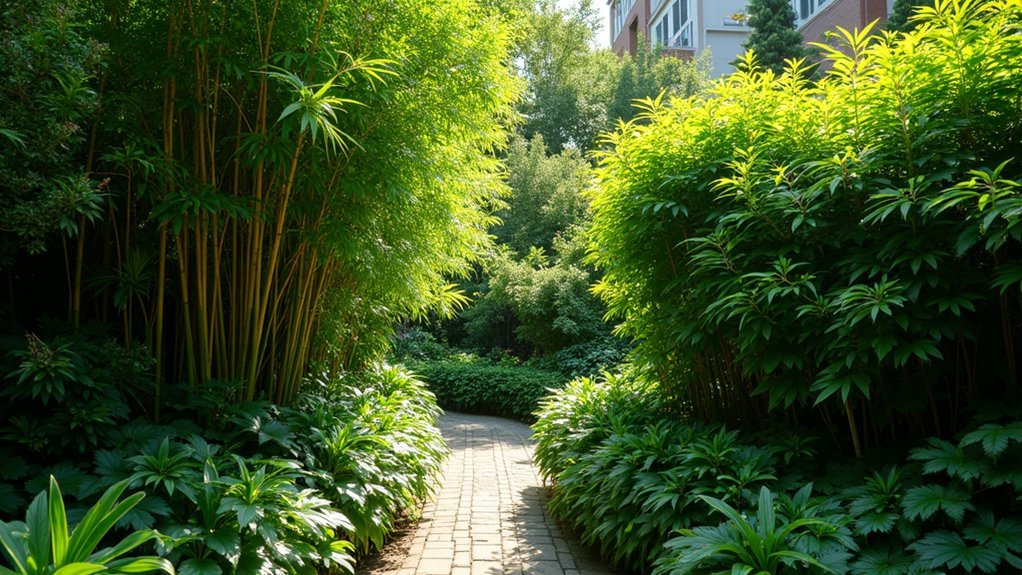
When you’re looking to create a peaceful outdoor sanctuary, strategic plant selection can make all the difference. Leyland Cypress and Arborvitae stand out as exceptional sound-absorbing plants, capable of reducing noise levels by up to 10 decibels with their dense foliage.
For peak effectiveness, consider broadleaf varieties like Holly and Photinia, whose thick leaves naturally absorb sound waves.
Creating mixed plantings with various species at different heights provides superior noise barriers compared to single-species arrangements, as diverse foliage types capture different sound frequencies.
Layer diverse plants at varying heights to create a superior sound barrier that captures multiple noise frequencies.
Plant your evergreen trees in staggered rows close to noise sources for ideal sound-blocking performance.
Don’t overlook ground covers like turf grass, which work alongside taller plants to create extensive effective sound barriers. This layered approach guarantees noise reduction from ground level upward.
Arborvitae Trees: Dense Year-Round Noise Protection
Homeowners seeking reliable sound barriers will find Arborvitae trees among the most effective natural noise reducers available.
These impressive evergreens, particularly Thuja Green Giants and Emerald Greens, feature exceptionally dense foliage that works year-round to absorb and deflect unwanted sound.
You’ll appreciate that these trees can be planted closer together than other varieties, creating a more compact sound barrier. For maximum noise reduction, consider planting Arborvitae in staggered rows, which greatly enhances their ability to block sound waves from busy streets.
With growth potential reaching 60 feet, these trees provide substantial noise protection from urban environments.
You’ll also enjoy their low-maintenance nature, requiring only minimal pruning to maintain their effectiveness as a natural sound barrier while simultaneously providing privacy for your property.
Holly Varieties: Broad-Leaved Sound Absorption Champions

Holly varieties offer another powerful option for those looking to reduce noise pollution naturally. Their thick, broad leaves excel at sound absorption, while their dense growth habit creates effective barriers against unwanted noise.
You’ll appreciate their glossy, evergreen leaves that maintain both noise reduction and aesthetic appeal year-round.
Consider these standout holly varieties for your sound-blocking needs:
- Nellie Stevens – Grows up to 20 feet tall and 18 feet wide, creating substantial noise barriers.
- American holly – Reaches impressive heights of 50 feet with 40-foot spread, perfect for blocking significant sound.
- Blue Prince and Castle Spire Blue bushes – Smaller options (8-12 feet) that still provide excellent sound absorption for limited spaces.
Cypress Trees: Tall Solutions for Maximum Noise Reduction
Towering champions of sound reduction, cypress trees stand as nature’s answer to urban noise pollution. Leyland Cypress, reaching impressive heights of 50-70 feet, creates an effective sound barrier with its exceptionally dense foliage.
You’ll appreciate how strategically planted cypress trees can reduce ambient noise by up to 10 decibels, dramatically enhancing your outdoor space’s tranquility.
The Carolina Sapphire Cypress offers both functional noise reduction and aesthetic appeal with its distinctive blue-green, feathery foliage.
Since most cypress varieties are evergreen, you’ll enjoy year-round protection from unwanted sounds and improved privacy.
For homeowners seeking quick results, Leyland Cypress’s rapid growth rate makes it an ideal choice when you need immediate sound-blocking solutions along busy roadways or noisy neighborhoods.
Colorful Sound Barriers: Aesthetic Plants That Block Noise
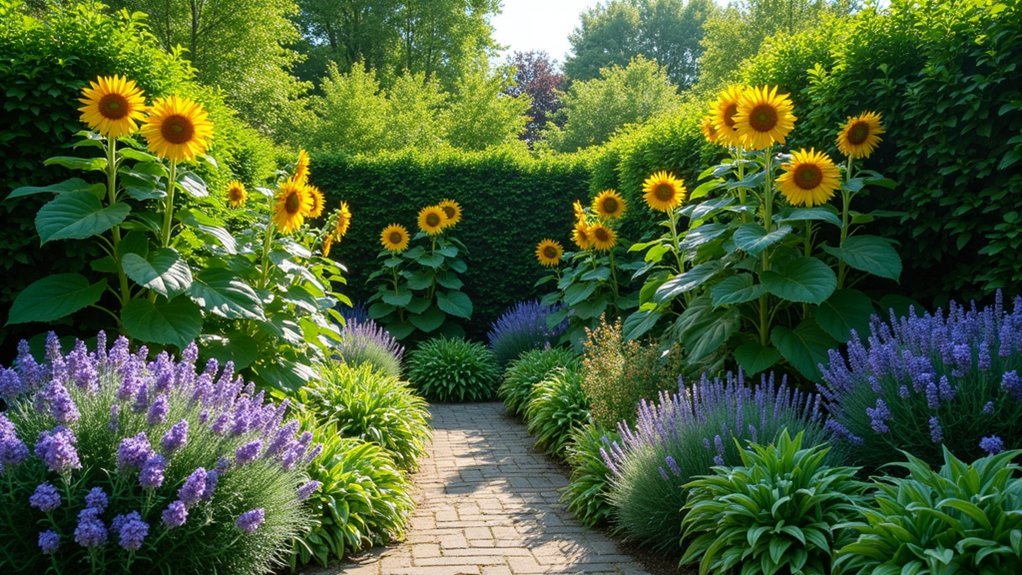
You don’t need to sacrifice beauty for functionality when creating a sound barrier in your garden.
Vibrant options like the Autumn Blaze Maple with its striking red foliage and colorful shrubs such as Azaleas and Hydrangeas effectively absorb noise while creating visual interest throughout the seasons.
Combining these aesthetic choices with traditional sound-blocking plants creates a privacy screen that’s both practical and pleasing to the eye.
Vibrant Blooms Absorb Sound
Beauty and function merge perfectly when vibrant blooms serve double duty as sound barriers in your landscape.
Plants with dense foliage like Autumn Blaze Maple don’t just provide stunning seasonal color—they effectively reduce noise by up to 10 decibels.
The broadleaf structure of flowering shrubs such as Azaleas and Hydrangeas enhances their sound-absorbing capabilities while adding vibrant splashes of color.
Create your own noise-reducing garden with these colorful options:
- Mix deciduous and evergreen plants like Redbud trees to maximize sound deflection year-round
- Plant Nandina and Pieris Mountain Fire shrubs for striking textures that absorb sound waves
- Arrange plants in varying heights to create a thorough sound barrier that’s visually appealing
You’ll enjoy both the peaceful environment and the beautiful scenery your absorbing plants provide.
Colorful Privacy Screens
While creating a tranquil outdoor space, colorful plants can simultaneously provide privacy and reduce unwanted noise. The Autumn Blaze Maple, growing up to 40 feet tall, delivers stunning visual appeal while its thick foliage effectively blocks sound.
For year-round noise reduction, combine deciduous trees like Redbud with evergreen shrubs. This strategy guarantees your privacy screen maintains its sound-absorbing capabilities even when seasonal trees lose their leaves.
Dense-growing shrubs such as Azaleas and Hydrangeas enhance your barrier’s aesthetics while contributing to noise dampening. For substantial height with color, consider Nandina or Hypericum Pumpkin placed strategically throughout your landscape.
You’ll enjoy the best results by creating a mixed planting of colorful, sound-absorbing plants at varying heights, giving you both the privacy and noise reduction you desire.
Beauty Meets Noise Control
Combining aesthetic appeal with practical noise reduction, colorful sound barriers transform ordinary landscapes into peaceful retreats.
You’ll find that strategic plant selection creates an effective barrier that serves dual purposes in your yard.
For the best sound absorption while maintaining visual interest:
- Mix Autumn Blaze Maple trees with Redbud varieties for height variation and seasonal color changes that effectively absorb sound while reaching up to 40 feet tall.
- Layer flowering shrubs like Azaleas and Hydrangeas beneath taller trees to create dense foliage that traps and diffuses noise waves.
- Incorporate evergreen holly varieties with colorful Pieris Mountain Fire for year-round noise control that can reduce sound levels by up to 10 decibels.
These plant combinations offer both beauty and functionality, making noise control an attractive addition to your outdoor space.
Strategic Planting Techniques for Enhanced Sound Blocking
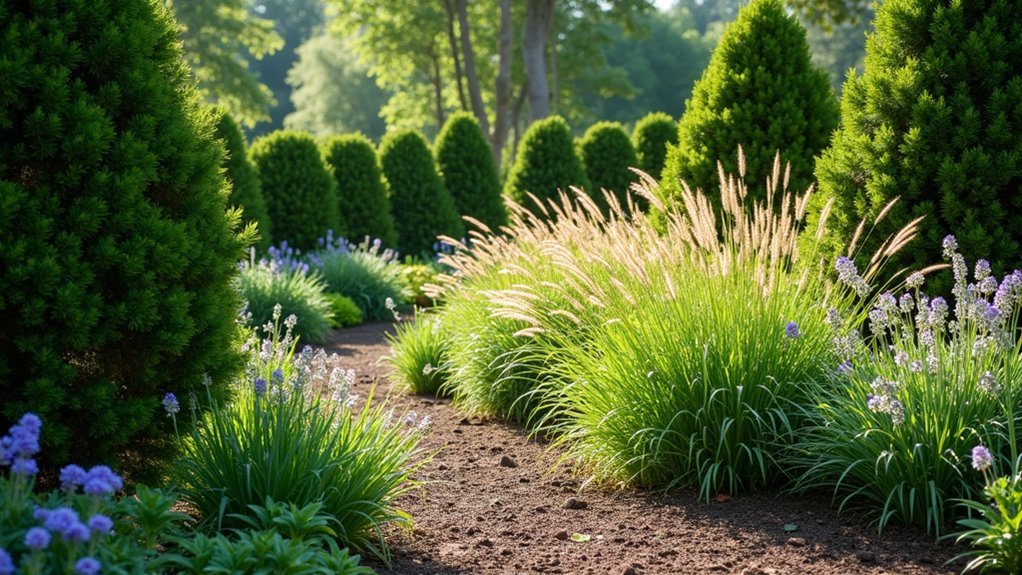
Creating an effective sound barrier requires more than simply adding greenery to your landscape.
You’ll achieve maximum noise reduction by strategically incorporating plants in staggered rows rather than single lines, creating a denser barrier that excels at absorbing sound.
Position shorter plants closest to the noise source with taller specimens behind them. Combine broadleaf and evergreen plants to tackle different sound frequencies, potentially reducing noise by up to 10 decibels when densely planted.
For even better results, install your living barrier on berms or slopes, as elevation helps deflect unwanted sounds.
Don’t neglect maintenance – regular pruning guarantees foliage remains thick all the way to the ground, which is vital for effective sound absorption.
This thorough approach transforms ordinary plantings into powerful acoustic shields.
Mixed Plantings: Why Diversity Improves Noise Reduction
When designing your sound barrier, you’ll get better results by combining plants of different heights to create a multi-layered shield against noise pollution.
The varied architecture catches sound waves at different levels, with low plants trapping ground-level noise while taller specimens block higher-traveling sounds.
Plants with complementary leaf structures—such as mixing broad-leaved shrubs with needle-bearing evergreens—will intercept and absorb a wider range of sound frequencies than single-species barriers.
Plant Height Variety
The strategic layering of plants at different heights forms the cornerstone of effective noise abatement.
When you combine tall trees with mid-level shrubs and low-growing plants, you’re creating multiple points of sound wave interference.
For maximum effectiveness:
- Position taller trees (30+ feet) at the back of your barrier, where they’ll block and deflect higher-traveling sound waves.
- Plant mid-height shrubs (6-15 feet) in the middle zone to capture mid-range frequencies that might pass through the canopy.
- Add low-growing vegetation (under 3 feet) at the front to absorb ground-level noise reflection.
This tiered approach guarantees sound waves encounter resistance at every level.
For best results, aim for at least 25 feet of broadleaf depth or 50-100 feet of conifers to achieve up to 10 decibels of noise reduction.
Complementary Leaf Structures
Diverse leaf structures working in concert create notably more effective sound barriers than uniform plantings. When you combine broadleaf and evergreen species, you’ll achieve up to 10 decibels of additional noise reduction compared to single-species arrangements. This happens because different leaf types absorb and deflect various sound frequencies.
For ideal blocking sound capability, plant broadleaf thickets at least 25 feet wide, while coniferous Trees and Shrubs should span 50-100 feet. Arrange your different types of plants in strategic layers, positioning taller species behind shorter ones to maximize sound wave interception.
Beyond effective noise reduction, these mixed plantings offer aesthetic benefits and create valuable wildlife habitat. The varied densities and textures of complementary leaf structures intercept, absorb, and diffuse sound waves across multiple frequencies—making your natural barrier considerably more efficient at quieting your environment.
Ground Cover Companions: Completing Your Sound Barrier
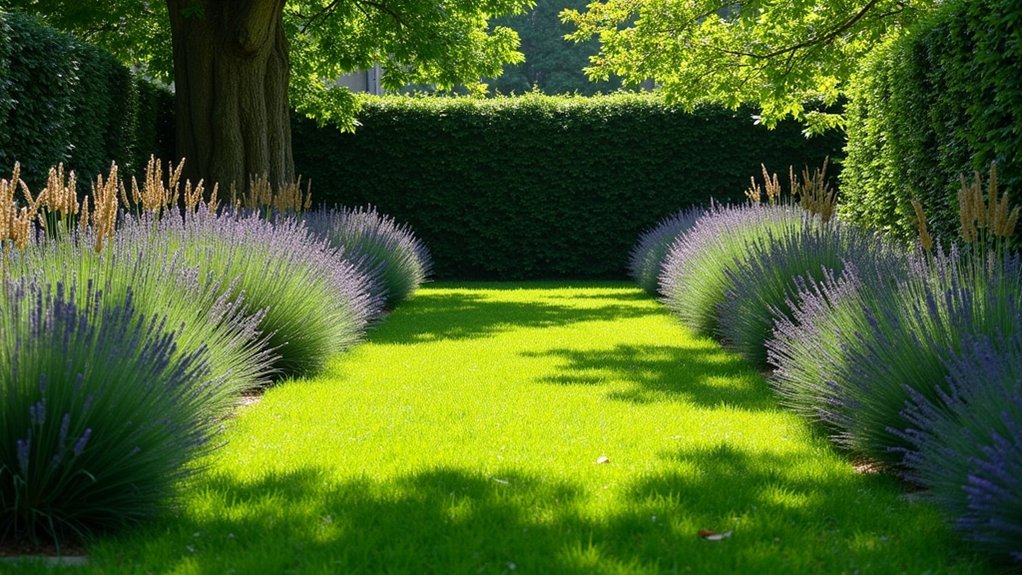
Creating a truly effective sound barrier requires more than just walls of tall shrubs and trees. Your noise reduction strategy should include ground cover plants, which absorb sound better than bare soil or paved areas.
Effective noise barriers must include ground cover plants—they absorb sound better than bare soil or hardscape elements.
When strategically placed near noise sources, low-growing vegetation complements the sound-blocking capabilities of taller plants.
For maximum effectiveness:
- Choose dense evergreen shrub varieties like creeping juniper that maintain sound absorption year-round.
- Mix different ground cover types to enhance both aesthetics and noise dampening properties.
- Maintain your ground cover regularly to guarantee ideal foliage density for noise reduction.
Fast-Growing Options for Immediate Noise Relief
When you’re looking for quick privacy solutions, fast-growing plants can transform your noisy outdoor space within just a few growing seasons.
Options like Leyland Cypress and Thuja Green Giant will rapidly establish themselves, growing several feet per year to create substantial sound barriers.
For the fastest results, combine multiple varieties such as Nellie Stevens Holly and Carolina Sapphire Cypress in strategic locations where noise pollution is most intrusive.
Overnight Privacy Solutions
For those seeking immediate relief from noisy neighbors or busy streets, several fast-growing plant options can transform your outdoor space virtually overnight. Leyland Cypress, reaching heights up to 70 feet, creates an impressive sound barrier that absorbs noise while providing dense privacy.
For maximum noise reduction, consider these strategic planting approaches:
- Create staggered rows of Arborvitae varieties like Thuja Green Giant, which grow an impressive 3-5 feet annually.
- Install Nellie Stevens Holly for a robust barrier reaching 20 feet tall and 18 feet wide, effectively blocking both sound and unwanted views.
- Implement mixed plantings of broadleaf and evergreen trees to enhance sound absorption while adding visual interest to your privacy barriers.
You’ll enjoy both immediate and long-term benefits as these plants continue to mature.
Rapid Barrier Development
While patience typically rewards gardeners, you don’t have to wait years for effective noise reduction in your outdoor space. Fast-growing trees can transform your property into a sound-dampening sanctuary quickly.
| Plant Type | Growth Rate | Max Height |
|---|---|---|
| Leyland Cypress | 3-4 ft/year | 50-70 ft |
| Thuja Green Giant | 3-5 ft/year | 30-40 ft |
| Nellie Stevens Holly | 3-5 ft/year | 15-25 ft |
For ideal noise reduction, consider planting in staggered arrangements rather than straight lines. This technique creates a denser sound barrier by eliminating direct paths for noise to travel through. Combining evergreens with deciduous fast-growing trees not only enhances sound-blocking effectiveness but also adds visual interest to your natural barrier. The thickness these plants achieve in just a few growing seasons will noticeably reduce unwanted neighborhood noise.
Evergreen vs. Deciduous: Choosing Based on Year-Round Needs
Because sound blocking remains effective only when foliage is present, your choice between evergreen and deciduous plants will greatly impact year-round noise reduction results.
Evergreens like Arborvitae and Cypress provide consistent noise blocking through all seasons, making them superior year-round noise blockers. Deciduous varieties offer strong summer protection but minimal winter coverage when leaves drop.
Dense evergreen foliage creates a living sound barrier that never takes a season off, unlike their deciduous counterparts.
When selecting the best plants for your noise barrier, consider:
- Timing needs – Choose fast-growing evergreens like Leyland Cypress for urgent noise reduction
- Maintenance requirements – Evergreens typically demand less upkeep than deciduous varieties
- Aesthetic preferences – A combined approach offers visual interest while maintaining some noise reduction year-round
For reliable, consistent sound blocking, evergreens should form the foundation of your natural noise barrier.
Frequently Asked Questions
What Is the Best Natural Sound Barrier?
Your best natural sound barrier is a dense mix of evergreen trees like Arborvitae, Holly, and Cypress. You’ll reduce noise up to 10 decibels when you strategically plant various species together for maximum absorption.
What Is the Best Plant Material to Use as a Sound Barrier?
You’ll get the best sound barrier from Arborvitae, Leyland Cypress, and mixed evergreen plantings with broad-leafed species like Hollies, Photinia and Yew. Create dense, multi-height barriers at least 25 feet wide for maximum noise reduction.
What Are the Best Sound Blocking Shrubs?
For sound blocking, you’ll want Nellie Stevens holly or Photinia for 20-foot barriers with dense foliage. Blue Prince and Steeds hollies reach 8 feet and are perfect for residential areas. Try combining varieties for better absorption.
Can Plants Act as a Sound Barrier?
Yes, plants can act as sound barriers. You’ll get the best results with dense evergreens and mixed plantings that can reduce noise by up to 10 decibels when strategically placed perpendicular to the sound source.
In Summary
You’ve now got a thorough toolkit for creating your own natural sound barrier. Whether you choose towering cypress trees or a diverse mix of holly and arborvitae, you’ll enjoy both noise reduction and enhanced beauty. Don’t forget to layer your plantings with complementary ground cover for maximum effectiveness. With the right selection of these plants, you’ll transform your noisy outdoor space into a peaceful sanctuary.

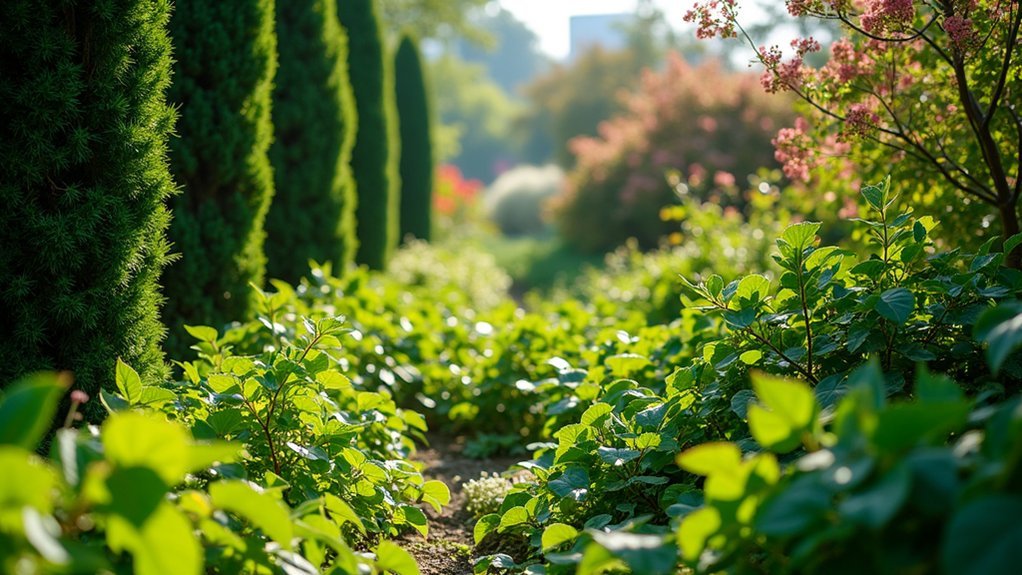

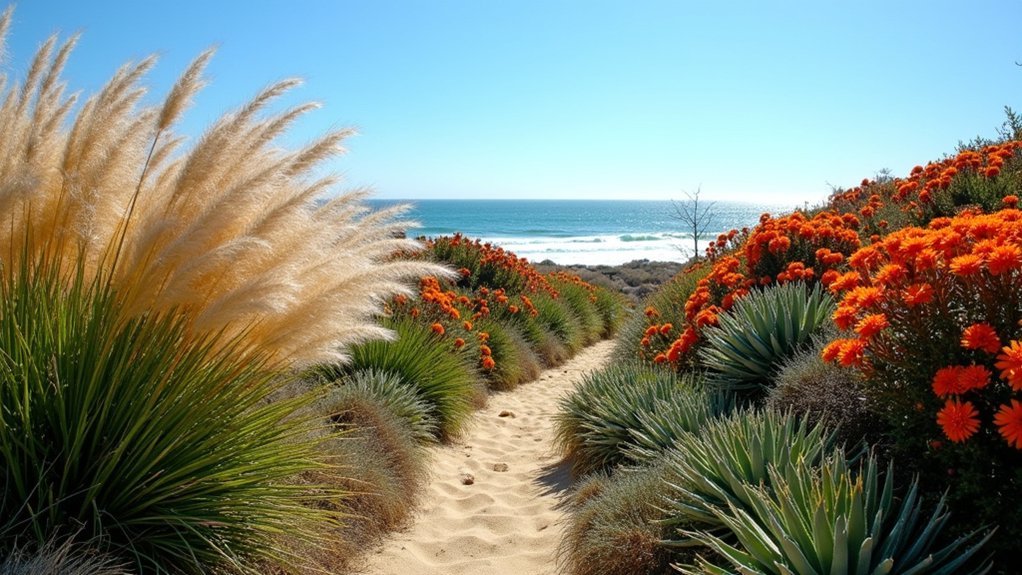
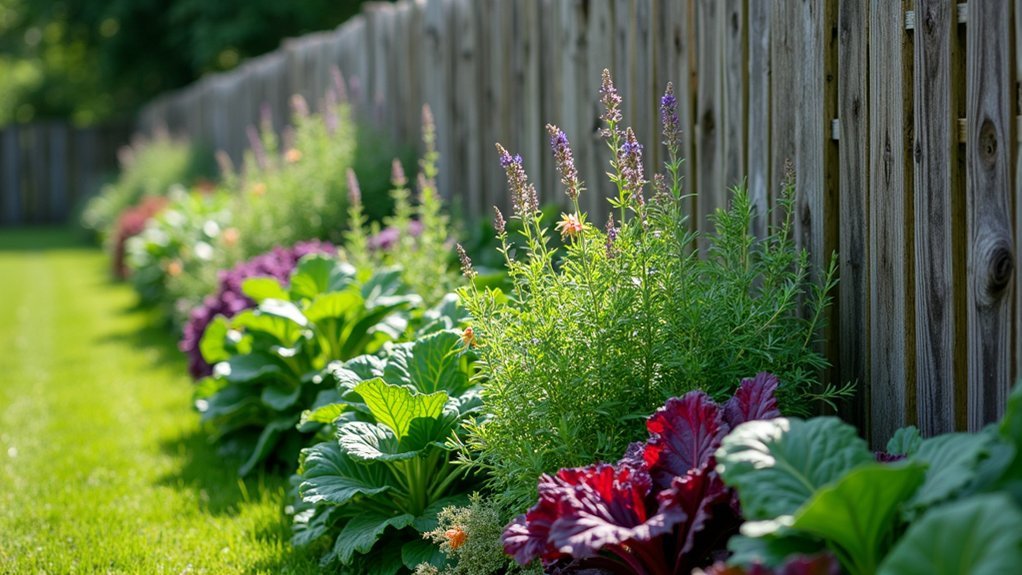
Leave a Reply